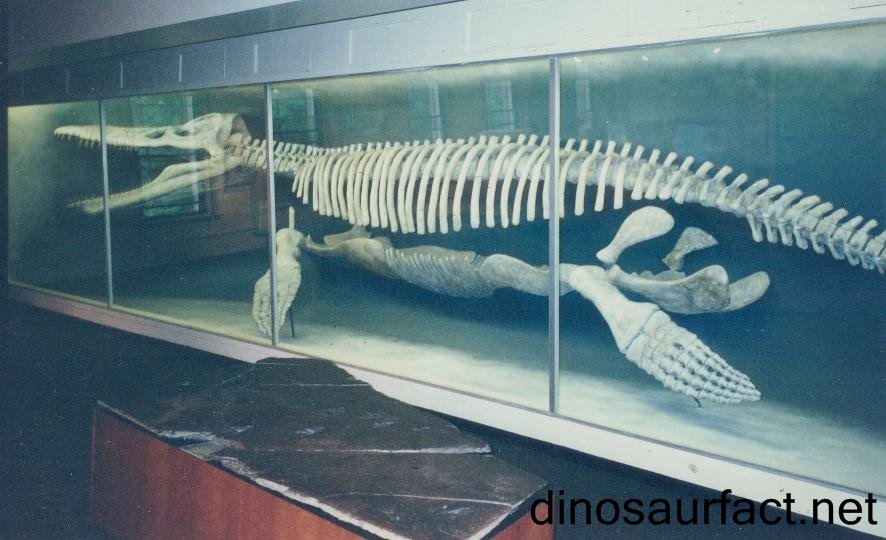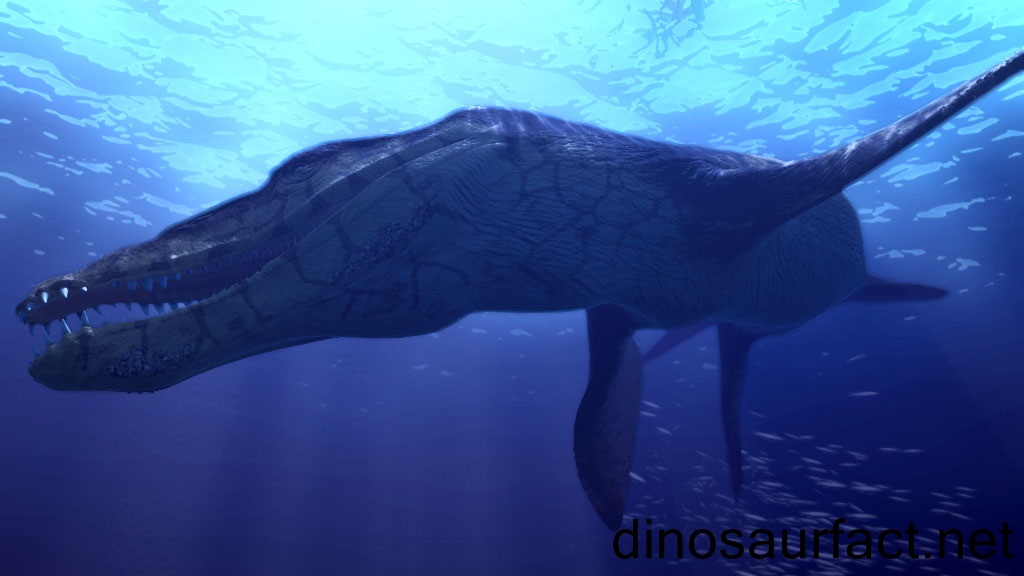 Click to visit the previous Marine Specie bio
Click to visit the previous Marine Specie bio
 |
|
 |
|
Kingdom: Animalia
Phylum: Chordata
Class: Reptilia
SuperOrder: Sauropterygia
Order: Plesiosauria
SubOrder: Pliosauroidea
Family: Pliosauridae
Genus: Kronosaurus
 |
|
 |
|
 |
|

The Kronosaurus was a large marine reptile that was in existence in the Cretaceous period. It was present on the earth about 123 to 98 million years ago. This time period lies between the Aptian and Cenomanian ages of the Cretaceous period.
The remains of the Kronosaurus were discovered in Australia and Columbia. This shows that it could have been present all over the Indian and Atlantic oceans during the prime of its existence.
The Kronosaurus was huge as compared to its contemporaries. Its length is estimated to be 30 to 35 feet. It possible weighed about 15 to 20 tons. Paleontologists believe that the Kronosaurus was at the top of its food chain. No other predator could compete with the size and strength of the Kronosaurus. Thus it is not surprising that the Kronosaurus should have had such a wide ranging reach in the Cretaceous oceans.
The Kronosaurus was a pliosaur. For some time, it was considered the largest pliosaur to ever be present on the planet. But the discovery of the Pliosaurus displaced the Kronosaurus from its position.
Etymology
The Kronosaurus was named after the Greek mythological being 'Cronus' who was known to devour his own children. As the Kronosaurus was considered to a feared predator of its time, it was named after Cronus. The suffix '-saurus' is derived from the Greek word 'sauros' which translates to 'lizard'. Thus the word 'Kronosaurus' roughly translates to 'Cronus's lizard'.
The binomial name Kronosaurus queenslandicus was derived from the Australian state of Queensland. These fossils were named by scientist Herber Longman.
The specific name of the second sub-species, K. boyacensis, is derived from the Columbian state of Boyaca.
Discovery of fossils
- The remains of the Kronosaurus were first found in the town of Hugenden in Queensland. They were discovered by Andrew Crombie in the year 1899. They remained unclassified for almost a quarter of a century as there were very few organisms available to compare the remains with at that period of time. They were thought to belong to an ichthyosaur.
- The fossils were finally described by Longman in the year 1929.
- William Scheville, who was a fossils collector associated with the Harvard University, visited Australia in the year 1932. He discovered some bones nearby the location in Hugenden where the holotype of the Kronosaurus was uncovered. These bones are today attributed to the Kronosaurus.
- A farmer in the Boyaca state of Columbia happened to find large skeleton while working in his fields in 1977. These fossils were examined and described by paleontologist Oliver Hampe. He named them the Kronosaurus boyacensis.
Nature of fossils
- The pilot sample uncovered by Andrew Crombie comprised of a large jaw having sharp, conical teeth.
- A partial post cranial skeleton was uncovered by Scheville during his expedition in 1932.
- The teeth of the Kronosaurus were not serrated like those of other pliosaurs.
- The skull of the Kronosaurus was massive; its length was almost 6 feet.
- The Kronosaurus had long snout, was evinced by its long jaw bones.
- The phalanges, as well as the bones of the manus and hock were elongated, indicating that they were modified to form flippers.
- The fossils discovered in Columbia are the better preserved than any other Kronosaurus fossils found till today.
Classification
The Kronosaurus is classified under super-order Sauropterygia, order Pleiosauria and family Pliosauridae.
Most of this classification has been done recently in the year 2011 as there was very little information available about pliosaurs when the fossils of the Kronosaurus were discovered.
Herber Longman
Albert Herber Longman was born in Wiltshire in England in 1880. He immigrated to Australia in the year 1902.
Longman was the founder of two Australian newspapers 'Rag' and 'Citizen'. He was also a published author.
He became the Director of the Queensland Museum in 1919, where he indulged his interests in vertebrate paleontology. Along with the Kronosaurus, Longman has named other vertebrates such as the Rhoetosaurus and the Euiyzygoma.
Physical features
- The Kronosaurus was a huge pliosaur, growing to the lengths of 10 to 11 meters. It was initially thought that the Kronosaurus could achieve an adult length of 13 to 14 meters, but this was found to be incorrect as scientists had overestimated the number of its vertebrae.
- The weight of the Kronosaurus is difficult to determine, but is estimated at around 18,000 to 20,000 kilos.
- The Kronosaurus had a large head and a very short but muscular neck. Its head took up more than a fourth of its body length.
- This feature is contrasting as compared to other pliosaurs which possessed long and slender necks.
- The forelimbs and hind limbs of the Kronosaurus were adapted for an aquatic environment. They were modified to form flippers.
- The Kronosaurus had a short and stout tail.
Habits and habitat
- The Kronosaurus had carnivorous feeding habits, which is shown by the shape of its teeth and the habits of other pliosaurs. Its teeth did not have ridges like those of other pliosaurs. This indicates that it either preyed on smaller fish or relied solely on the strength of its neck to tear apart its prey. Its teeth would not have been sufficient for a tearing action. The other possibility is that the Kronosaurus swallowed its prey whole.
- There is no evidence that the Kronosaurus was viviparous. However, it is equally unlikely that such a large creature would come ashore to lay eggs. There is presently no consensus on the reproductive habits of the Kronosaurus.
- The Kronosaurus preyed on fishes, squids, ichthyosaurs and other pliosaurs. The fossils of the Eromangasaurus show teeth marks which are believed to have been left there by a Kronosaurus.
- The habitat of Kronosaurus most likely consisted of deep waters. The scarcity of its fossils and its size indicate that it did not live in shallow water bodies.
Related and coexisting species
The Kronosaurus was related to other pliosaurs such as the Liopleurodon, Megacephalosaurus and the Brachauchenius.
It probably coexisted with the Eromangasaurus along with other Cretaceous sharks, teleosts, ichthyosaurs and rays.
Conclusion
The Kronosaurus was a top predator of its day. The advent of the giant marine organisms began with the Kronosaurus and hence paleontologists are fascinated by it even today.
The Kronosaurus was different physically and physiologically as compared to other pliosaurs. Its reproductive and respiratory systems are still a mystery. If and when more fossils are discovered, more information will be obtained about this magnificent creature.
Index
Extinct Profiles
 Triassic Dinosaurs
Triassic Dinosaurs Jurassic Dinosaurs
Jurassic Dinosaurs Cretaceous Dinosaurs
Cretaceous Dinosaurs Pterosaurs
Pterosaurs Marine Reptiles
Marine Reptiles Dinosaur Extinction
Dinosaur Extinction